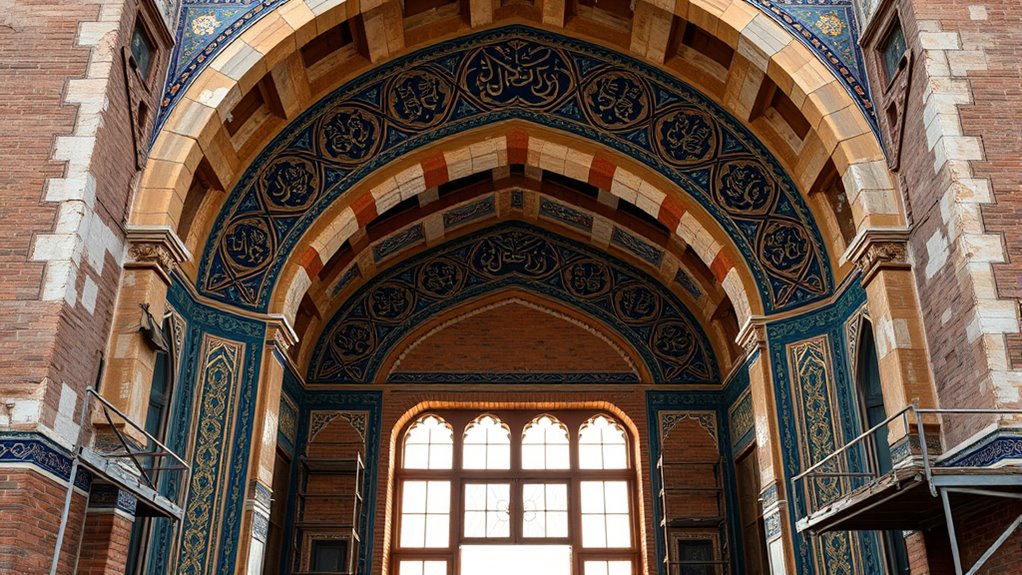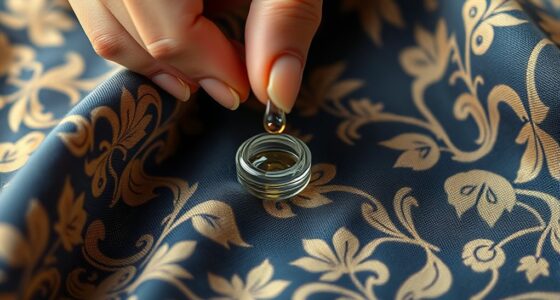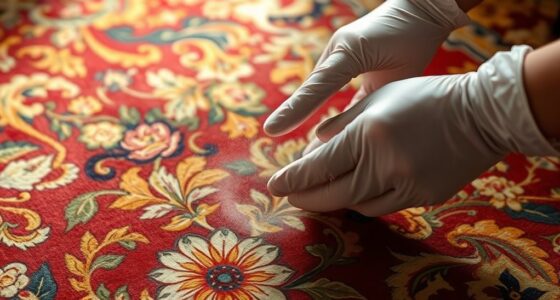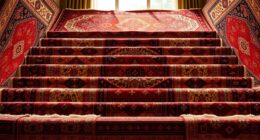In restoring a 19th-century Tabriz to gallery condition, you’ll discover how experts carefully assess historic damage using visual inspections, diagnostic tools, and material analysis. Preservation efforts blend traditional techniques like lime plaster and mortar with modern reinforcements to guarantee structural stability. Addressing previous repairs and protecting cultural authenticity remain essential. If you want to understand how these strategies work together to restore this historic space, continued exploration reveals the detailed process involved.
Key Takeaways
- Comprehensive damage assessment combined visual inspection, diagnostic imaging, and material analysis to inform restoration strategies.
- Structural reinforcement techniques, including foundation underpinning and wall stabilization, ensured long-term stability.
- Preservation prioritized original materials like lime plaster, traditional mortar, and timber, integrating modern breathable coatings.
- Careful lighting design and environmental monitoring enhanced artwork visibility while minimizing deterioration risks.
- Stakeholder engagement and adherence to conservation ethics balanced historical integrity with modern enhancements.
Historical Background and Significance of the Tabriz
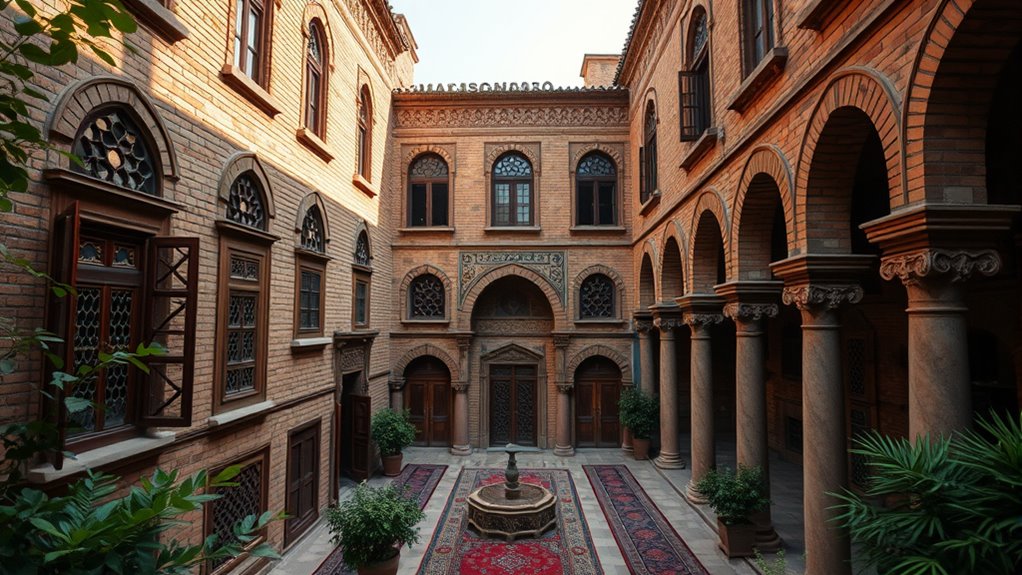
Tabriz, a city with a rich history dating back over a thousand years, has long served as an essential cultural and economic hub in the region. Its architecture reflects deep symbolism, showcasing intricate designs that embody local beliefs and traditions. Over centuries, these structures reveal layers of history through their architectural symbolism, highlighting the city’s significance. However, material degradation has taken its toll, causing surfaces to weaken and details to fade. You’ll notice how weathering, pollution, and neglect threaten the city’s historic fabric. Preserving Tabriz’s legacy requires understanding both its symbolic architectural elements and the challenges posed by material deterioration. Regular maintenance and restoration techniques strategies can also play a role in raising awareness and funding restoration projects. Implementing advanced preservation technologies can further enhance restoration efforts while safeguarding the city’s authenticity. This background underscores why restoration efforts are crucial to maintain the city’s cultural identity and ensure future generations can appreciate its historical importance.
Assessing the State of Preservation and Damage
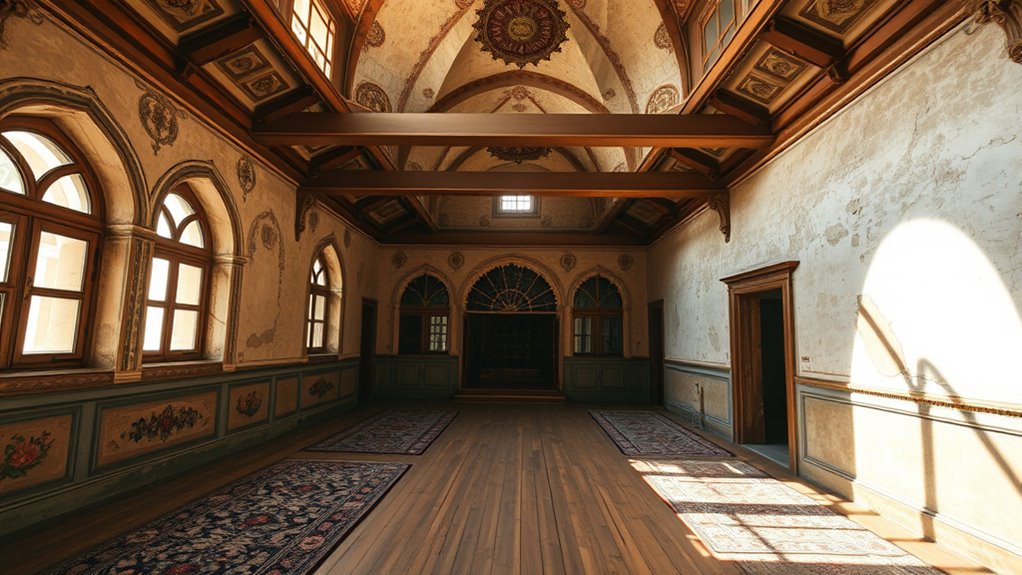
To accurately assess the building’s condition, you’ll start with visual inspection techniques to spot obvious issues. Next, you’ll employ damage identification methods to determine the extent and causes of deterioration. This approach guarantees a thorough understanding of what needs urgent attention and long-term preservation. Incorporating color accuracy assessments can also help identify areas where visual discrepancies may indicate underlying structural or material issues. Additionally, understanding asset division laws and the legal implications of property division can guide your decision-making during assessment. Employing self-watering plant pots as a metaphor, regularly monitoring and maintaining the integrity of the structure ensures it remains healthy and functional over time. Recognizing the importance of appliance maintenance plans and scheduled inspections can serve as an analogy for ongoing preservation efforts, ensuring the building’s longevity.
Visual Inspection Techniques
Visual inspection serves as the foundation for evaluating the current condition of 19th-century artifacts, allowing conservators to identify visible signs of deterioration quickly. You check lighting conditions carefully, as improper lighting can cause or hide damage, affecting your assessment. Bright, even lighting reveals surface details and subtle changes, while dim or uneven light may obscure issues. Mold detection is also essential during visual inspection; look for discoloration, fuzzy growth, or unusual textures on surfaces. Regularly inspecting artifacts in different lighting angles helps uncover hidden deterioration. Additionally, understanding ceiling fan safety can prevent accidental damage during handling and inspection. Proper lighting not only improves visibility but also minimizes the risk of damage due to improper handling, ensuring the artifact remains preserved during examination. By systematically observing these factors, you gain a clear understanding of the object’s preservation state, guiding further analysis and treatment decisions effectively.
Damage Identification Methods
Evaluating the true condition of 19th-century artifacts requires a combination of diagnostic methods that go beyond surface observation. You’ll use techniques like infrared imaging, X-ray fluorescence, and microscopy to identify hidden damages, previous repairs, and material degradation. These methods help you understand the artifact’s internal structure and material compatibility, which are vital for ethical restoration. Incorporating advanced diagnostic techniques can further enhance your understanding of complex preservation challenges and improve restoration outcomes. Additionally, employing non-invasive analysis methods ensures minimal impact on the artifact’s surface while gaining valuable insight into its condition. Regular monitoring with air quality indicators can also help detect environmental factors that may contribute to deterioration over time. Implementing sustainable conservation practices can help minimize environmental impact and promote long-term preservation of cultural heritage. Applying somatic therapy principles such as body awareness techniques can also be useful for conservators managing stress during delicate restoration processes.
Initial Documentation and Research Methods

When beginning the restoration of a 19th-century Tabriz building, thorough initial documentation and research are vital. You should start with digital documentation to create accurate records of the building’s current condition, including detailed photographs, 3D scans, and architectural drawings. This provides a baseline for tracking changes and planning interventions. Environmental monitoring is also indispensable; by evaluating humidity, temperature, and pollutant levels, you can identify factors contributing to deterioration. Gathering historical data, original construction techniques, and material analysis helps you understand the building’s context and craftsmanship. Combining these methods ensures you have an extensive understanding of the structure’s state, guiding your restoration strategy and helping preserve its historic integrity effectively. Understanding preservation principles can further inform the appropriate techniques to ensure authenticity and longevity. Additionally, staying informed about family photoshoot fails can help anticipate unexpected challenges during site assessments. Incorporating cultural significance into your research ensures that restoration efforts honor the building’s historical value and cultural identity.
Selecting Appropriate Restoration Materials and Techniques
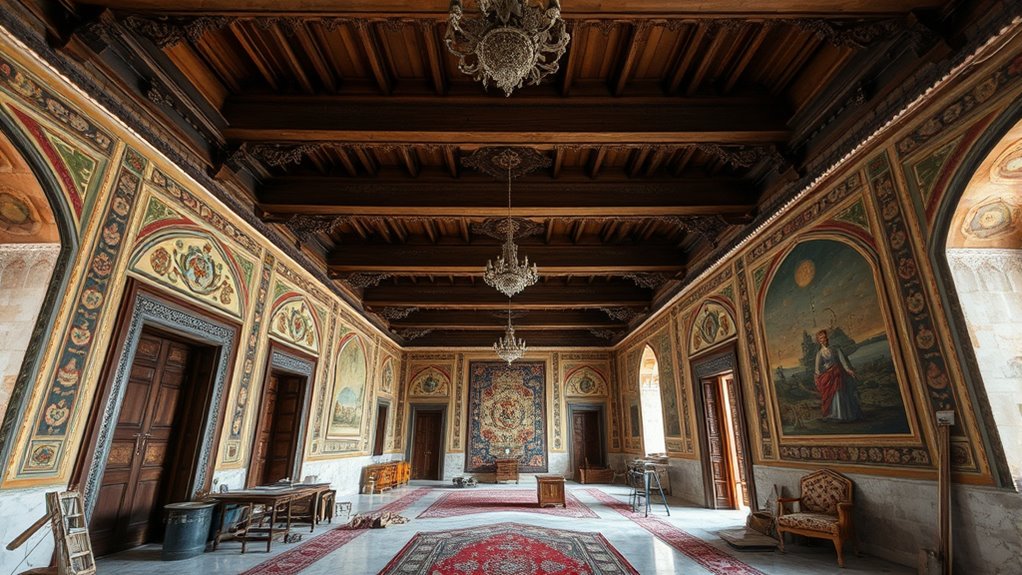
Building on your thorough documentation and research, selecting the right restoration materials and techniques is key to ensuring both the longevity and authenticity of the 19th-century Tabriz building. You must balance traditional methods with modern material adaptations, avoiding unrelated conservation techniques that could compromise integrity. Consider using compatible materials that match the original aesthetic and structural qualities. For example, traditional lime plaster can be combined with modern breathable coatings for durability. Here’s a comparison:
| Traditional Techniques | Modern Material Adaptations |
|---|---|
| Lime mortar | Polymer-modified lime |
| Natural pigments | Eco-friendly synthetic dyes |
| Hand-applied finishes | Spray application methods |
| Unrelated conservation techniques | Compatible, site-specific solutions |
| Traditional tools | Precision modern tools |
Choosing wisely ensures both preservation and future resilience.
Structural Reinforcement and Stability Improvements
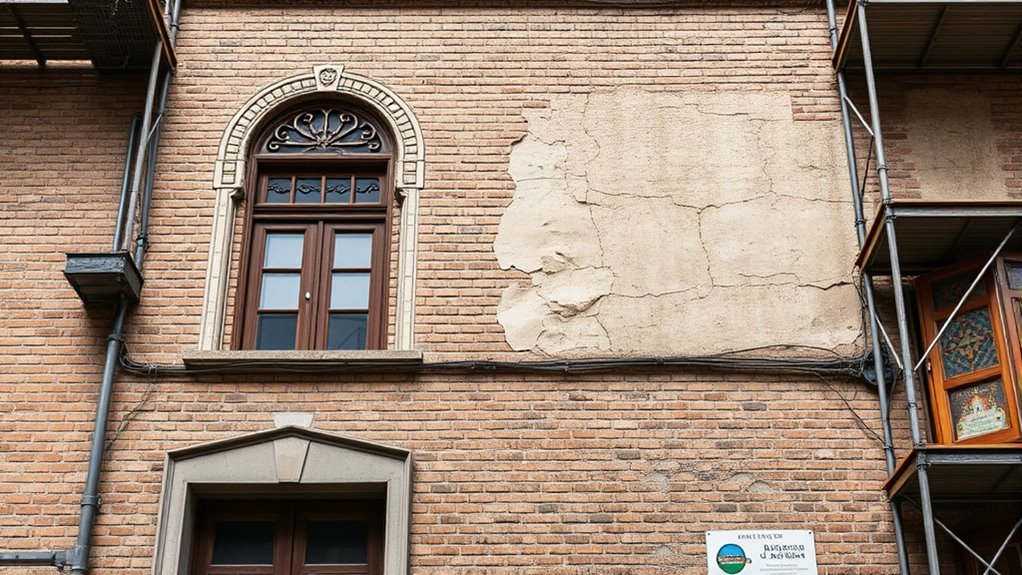
To guarantee the building’s stability, you focus on foundation strengthening techniques that provide a solid base. Reinforcing the walls with modern strategies helps prevent future damage, while upgrading the roof and ceiling supports maintains overall structural integrity. These steps are vital for preserving the historical character while making the structure safer for years to come.
Foundation Strengthening Techniques
Strengthening a historic foundation requires precise techniques that enhance stability without compromising the structure’s integrity. Start with a thorough subsurface analysis to identify weaknesses and soil conditions, ensuring your approach aligns with the existing foundation. Foundation underpinning is often necessary to improve load distribution and prevent settlement. You might choose methods like pile underpinning, micropiles, or beam and slab reinforcement, depending on the foundation’s condition. These techniques stabilize the structure while preserving its historic features. Careful planning and expert execution are essential to avoid damaging the original materials. By combining detailed analysis with targeted underpinning solutions, you can confidently reinforce the foundation, ensuring long-term stability and safeguarding the building’s historic significance.
Wall Reinforcement Strategies
After reinforcing the foundation, focusing on wall reinforcement strategies becomes essential to guarantee overall stability. You’ll incorporate structural solutions like steel supports and internal bracing, ensuring load distribution and resilience. Ceramic analysis helps identify original materials, guiding compatible repairs that preserve authenticity. Moisture mitigation is critical; installing vapor barriers and proper drainage prevents water intrusion, protecting walls from deterioration. You might use reinforcing meshes or grout injections to stabilize weakened areas. Consider this setup:
| Structural Support | Moisture Control |
|---|---|
| Steel braces | Vapor barriers |
| Reinforcing meshes | Drainage systems |
| Grout injections | Sealants |
These strategies work together to strengthen the walls and safeguard your restoration efforts, maintaining the building’s integrity for future generations.
Roof and Ceiling Support
Ensuring the roof and ceiling support remains stable is vital for preserving the structural integrity of the building. Respecting conservation ethics means carefully reinforcing existing structures without compromising authenticity. Your approach involves engaging the community, valuing their input and connection to the site. Key steps include:
- Evaluating the current stability and identifying weaknesses in the roof and ceiling.
- Using minimally invasive reinforcement techniques to maintain historical integrity.
- Integrating modern materials that complement original craftsmanship.
- Involving local artisans and residents to foster shared responsibility for preservation.
This collaborative effort aligns with conservation ethics, emphasizing respect for the building’s history, while community involvement ensures sustainable support and appreciation for the restored structure.
Restoring Decorative Elements and Artistic Features
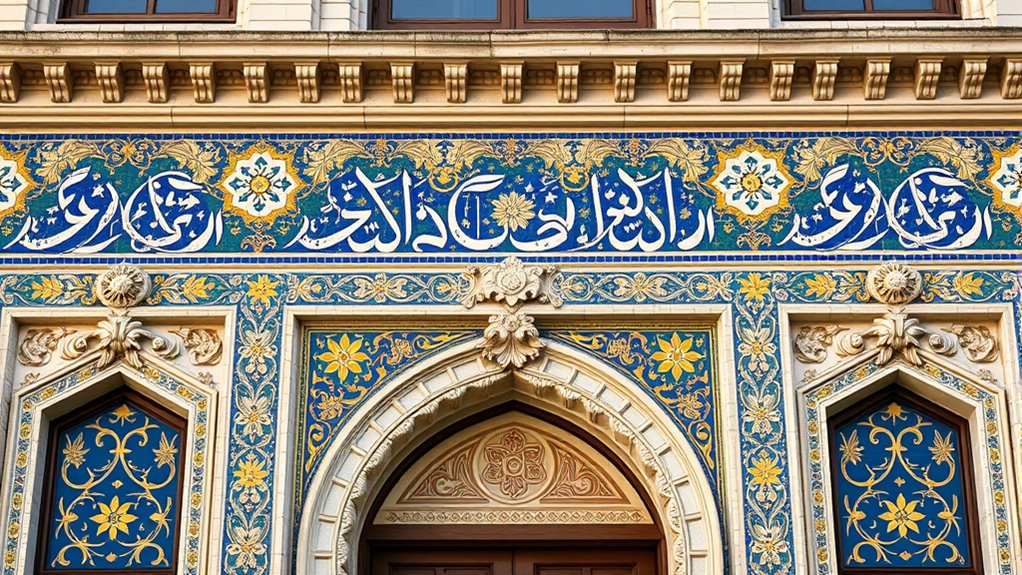
Restoring decorative elements and artistic features involves carefully analyzing the original craftsmanship to preserve their aesthetic integrity. You start by examining the fresco techniques used, understanding the layering and application methods that define the artwork’s character. Color analysis plays a vital role, helping you identify original hues and how they have aged or faded over time. This allows you to select appropriate materials for touch-ups that match the historic palette seamlessly. You meticulously clean and repair damaged sections, ensuring that the restorations blend with the original work. Every brushstroke is guided by a deep respect for the artist’s intent and techniques. By doing so, you restore the visual harmony and cultural value of the decorative elements without compromising their historical authenticity.
Addressing Modern Interventions and Previous Repairs

Modern interventions and previous repairs often present unique challenges when restoring historic structures like the 19th-century Tabriz. These alterations can obscure original craftsmanship and complicate conservation efforts. To address this, you should:
Modern repairs can obscure original craftsmanship, requiring careful assessment for authentic restoration.
- Carefully document all modern interventions and previous repairs to understand their scope.
- Assess the materials used, distinguishing between original and non-original elements.
- Develop a removal plan for inappropriate modern interventions without damaging authentic features.
- Apply appropriate restoration techniques to restore structural integrity and aesthetic authenticity.
Handling these aspects requires a delicate balance—preserving the building’s historic integrity while minimizing the impact of past repairs. Recognizing the significance of each intervention ensures a respectful, accurate restoration process.
Ensuring Cultural Authenticity in Restoration Process

Preserving the cultural authenticity of a historic site like 19th-century Tabriz requires a meticulous approach that respects its original context and significance. During ceramic restoration, you carefully select materials and techniques that match the original craftsmanship, avoiding modern substitutions that could compromise authenticity. Lighting enhancement must also be thoughtfully implemented; you aim to highlight architectural features without altering the site’s historical ambiance. Using period-appropriate lighting fixtures and subtle illumination preserves the site’s integrity while improving visibility. Every decision you make prioritizes maintaining the site’s aesthetic and historical value. By balancing technical restoration methods with cultural sensitivity, you ensure that Tabriz’s heritage remains genuine and true to its original character for future generations to appreciate.
Challenges Encountered and Problem-Solving Strategies
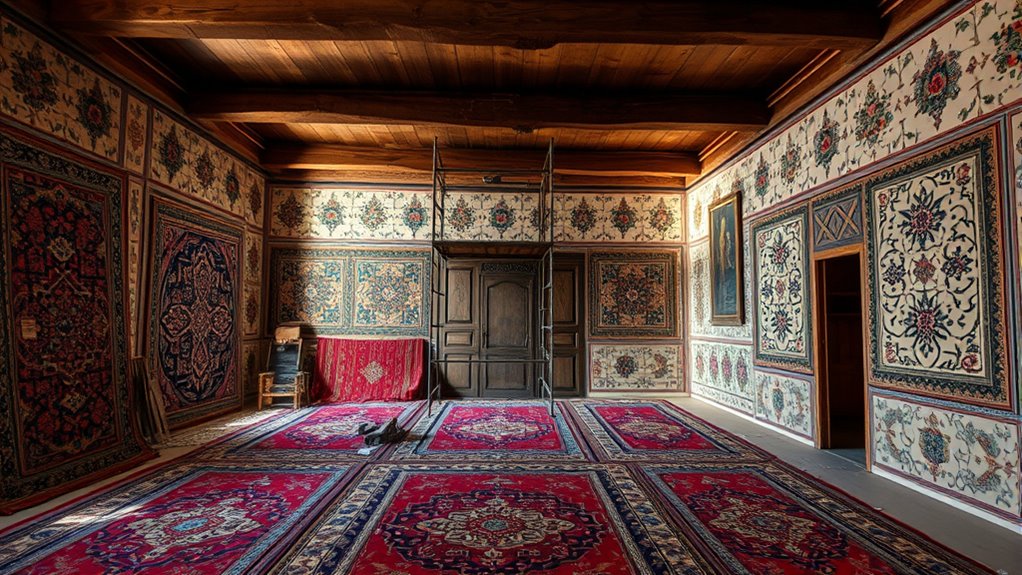
You’ll encounter challenges in preserving the building’s original materials and repairing structural damage. Finding suitable solutions requires careful assessment and innovative techniques. Addressing these issues is essential to maintain the authenticity and stability of the restoration.
Preservation of Original Materials
Restoring the original materials of a 19th-century Tabriz building presents significant challenges, as these materials often suffer from deterioration, environmental damage, and previous repairs that may have compromised their integrity. You must carefully distinguish authentic elements from artificial aging or modern additions that can obscure original craftsmanship. To preserve the building effectively, consider these strategies:
- Conduct detailed material analysis to identify original components.
- Use gentle cleaning methods to avoid further damage.
- Match new materials closely to original ones for seamless integration.
- Remove or minimize artificial aging effects that distort historical accuracy.
Addressing Structural Damage
Addressing structural damage in a 19th-century Tabriz building often involves overcoming complex issues caused by age, environmental factors, and previous repairs. You’ll need to carefully assess the timber framing, which may be weakened or decayed, compromising stability. Installing effective moisture barriers becomes essential to prevent further water infiltration that accelerates deterioration. You might encounter areas where wood rot has compromised load-bearing elements, requiring targeted reinforcement or replacement. When repairing timber framing, preserve as much of the original material as possible, ensuring structural integrity without altering historical character. Using modern moisture barriers strategically helps protect the restored elements from future damage. Throughout, your goal is to stabilize the structure while respecting its historical fabric, balancing preservation with necessary interventions.
Final Outcomes and Lessons Learned

The restoration project yielded remarkable results, blending historical authenticity with modern preservation techniques. You successfully integrated modern lighting to enhance the gallery’s ambiance while respecting its original design. Visitor accessibility improved markedly, making the space welcoming to all. Key lessons learned include:
- Prioritizing structural stability early prevents costly repairs later.
- Combining traditional craftsmanship with modern tools yields authentic results.
- Thoughtful lighting design enhances artwork visibility without compromising historical integrity.
- Engaging stakeholders ensures project goals align with visitor needs and preservation standards.
Frequently Asked Questions
How Does the Restoration Process Impact the Building’s Historical Authenticity?
You might wonder how restoration affects a building’s architectural authenticity, especially amid preservation challenges. When you restore a structure, you aim to preserve its historical integrity, but sometimes updates can compromise authenticity if not carefully managed. Balancing modern techniques with original features is essential. Effective restoration enhances the building’s cultural value, yet it requires meticulous effort to maintain its true historical essence without overshadowing its original craftsmanship.
What Are the Long-Term Preservation Strategies After Restoration Completion?
After restoration, you should focus on long-term preservation strategies like regular maintenance of architectural detailing and ongoing material conservation. You’ll want to implement a detailed preservation plan, including routine inspections and timely repairs, to prevent deterioration. Using appropriate materials and techniques guarantees the building’s authenticity remains intact. Educate staff about proper care and document all interventions, helping you maintain the building’s historical integrity for future generations.
How Are Modern Safety Standards Integrated Into Historic Building Restoration?
You’ve got to keep your eye on the ball when integrating modern safety standards into historic building restoration. Start with architectural conservation principles that respect original design while ensuring safety. Incorporate structural reinforcement where needed to meet current codes. This way, you balance preservation with safety, creating a space that’s both true to its past and ready for the future. It’s about making sure the building stands tall for generations to come.
What Community Involvement or Stakeholder Input Was Incorporated?
You engage in community consultation and stakeholder engagement to guarantee their voices shape the restoration. You hold public meetings, gather feedback, and include local artisans and residents in decision-making. This collaborative approach helps you address community needs, preserve cultural significance, and gain support for the project. By actively involving stakeholders, you create a restoration plan that respects local history while fostering a sense of shared ownership and pride.
How Is Environmental Sustainability Considered During Restoration Efforts?
You prioritize environmental sustainability by choosing sustainable materials that minimize ecological impact during restoration. You also focus on energy efficiency, implementing measures like improved insulation and energy-saving systems to reduce the building’s carbon footprint. These efforts ensure the project aligns with ecological principles, conserving the structure while promoting responsible resource use. By integrating sustainable practices, you help safeguard the environment for future generations while restoring the historical site effectively.
Conclusion
By restoring Tabriz to its pristine gallery condition, you don’t just preserve a building—you revive a timeless masterpiece that holds the soul of history itself. Every crack mended and detail preserved transforms you into a guardian of cultural eternity, proving that your efforts can turn mere bricks into a living testament of resilience. Remember, in this act of restoration, you’re not just fixing a structure—you’re safeguarding an everlasting legacy for generations to come.
